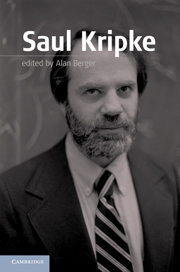Book contents
- Frontmatter
- Contents
- List of Contributors
- Introduction to Kripke
- Part I Naming, Necessity, and Apriority
- 1 Kripke on Proper and General Names
- 2 Fiction, Myth, and Reality
- 3 Kripke on Epistemic and Metaphysical Possibility
- 4 Possible Worlds Semantics
- Part II Formal Semantics, Truth, Philosophy of Mathematics, and Philosophy of Logic
- Part III Language and Mind
- Part IV Philosophy of Mind and Philosophical Psychology
- Index
- References
3 - Kripke on Epistemic and Metaphysical Possibility
Two Routes to the Necessary A Posteriori
Published online by Cambridge University Press: 05 June 2012
- Frontmatter
- Contents
- List of Contributors
- Introduction to Kripke
- Part I Naming, Necessity, and Apriority
- 1 Kripke on Proper and General Names
- 2 Fiction, Myth, and Reality
- 3 Kripke on Epistemic and Metaphysical Possibility
- 4 Possible Worlds Semantics
- Part II Formal Semantics, Truth, Philosophy of Mathematics, and Philosophy of Logic
- Part III Language and Mind
- Part IV Philosophy of Mind and Philosophical Psychology
- Index
- References
Summary
Saul Kripke’s discussion of the necessary a posteriori in Naming and Necessity and “Identity and Necessity” – in which he lays the foundation for distinguishing epistemic from metaphysical possibility and explaining the relationship between the two – is, in my opinion, one of the outstanding achievements of twentieth-century philosophy. My aim in this essay is to extract the enduring lessons of his discussion, and disentangle them from certain difficulties that, alas, can also be found there. I will argue that there are, in fact, two Kripkean routes to the necessary a posteriori – one correct and philosophically far-reaching, the other incorrect and philosophically misleading.
Keywords
- Type
- Chapter
- Information
- Saul Kripke , pp. 78 - 99Publisher: Cambridge University PressPrint publication year: 2011
References
- 9
- Cited by

